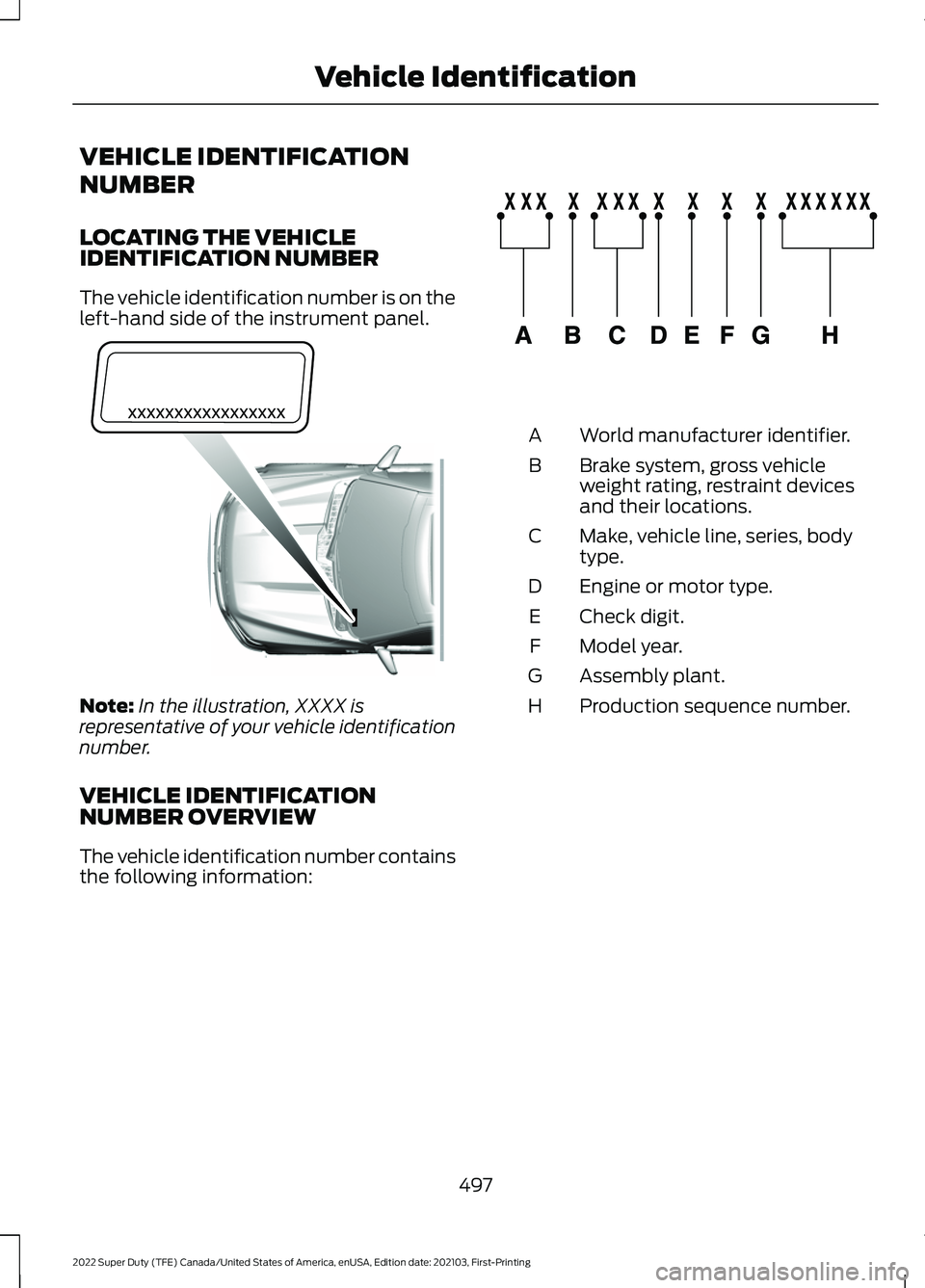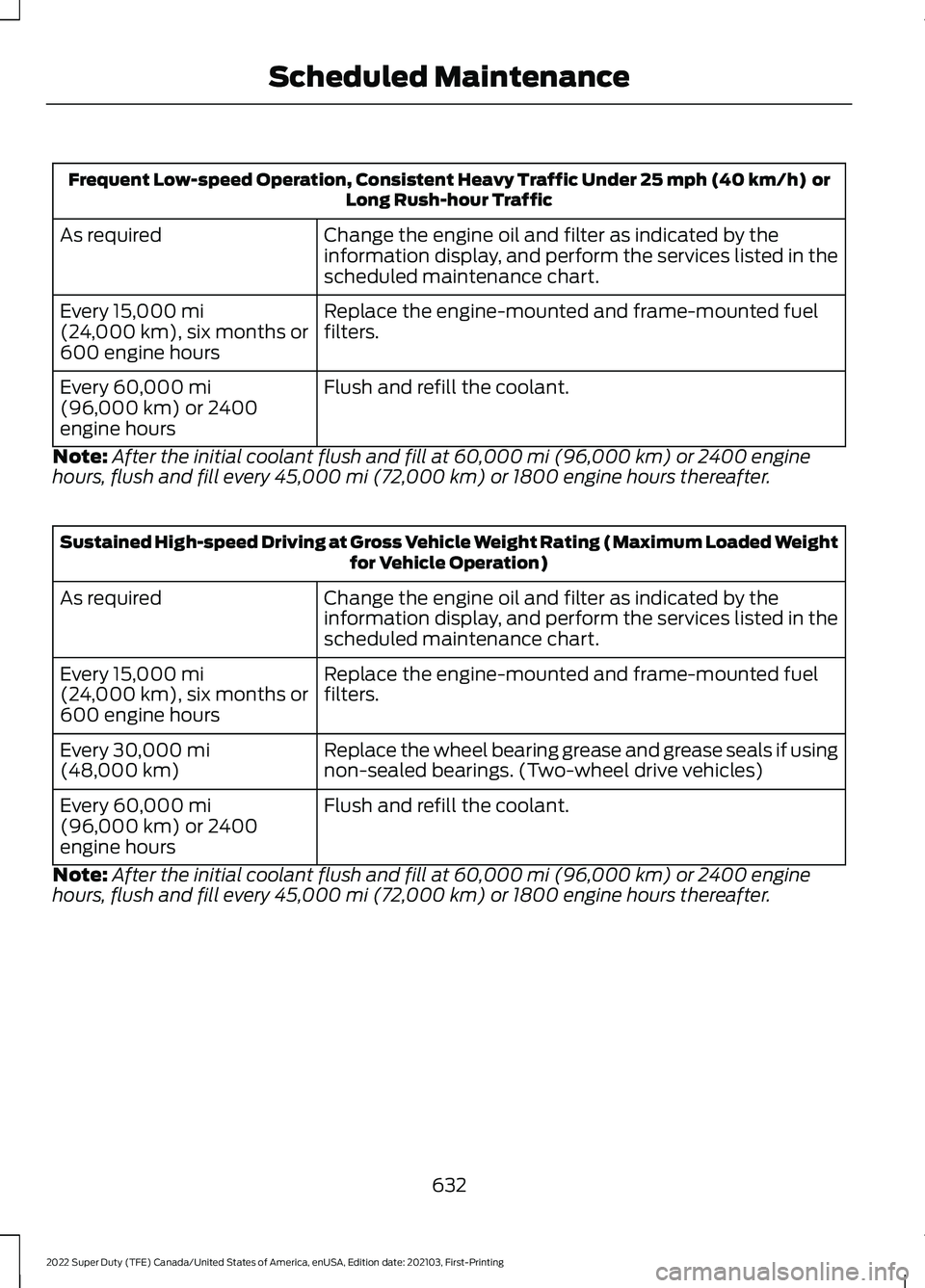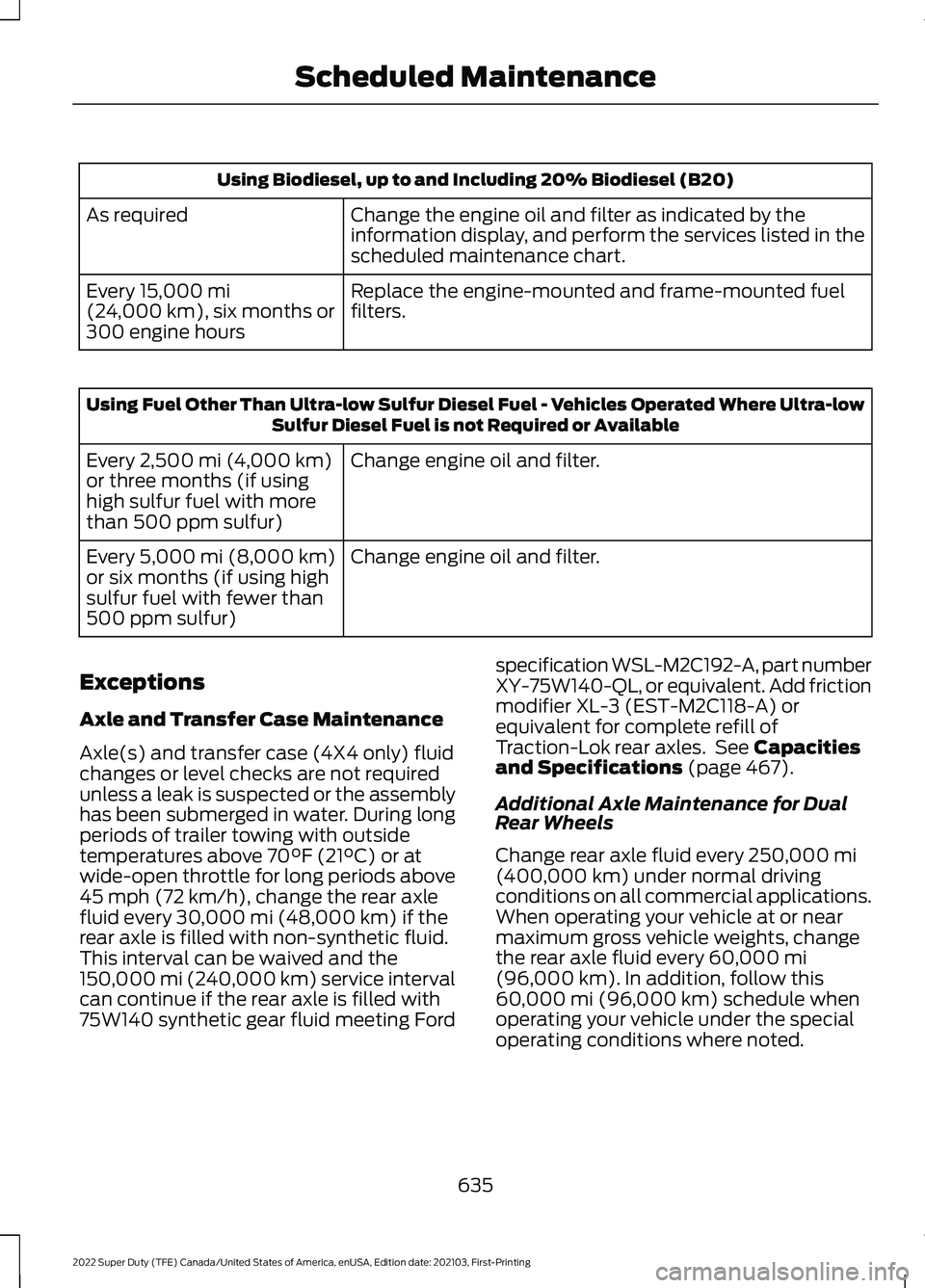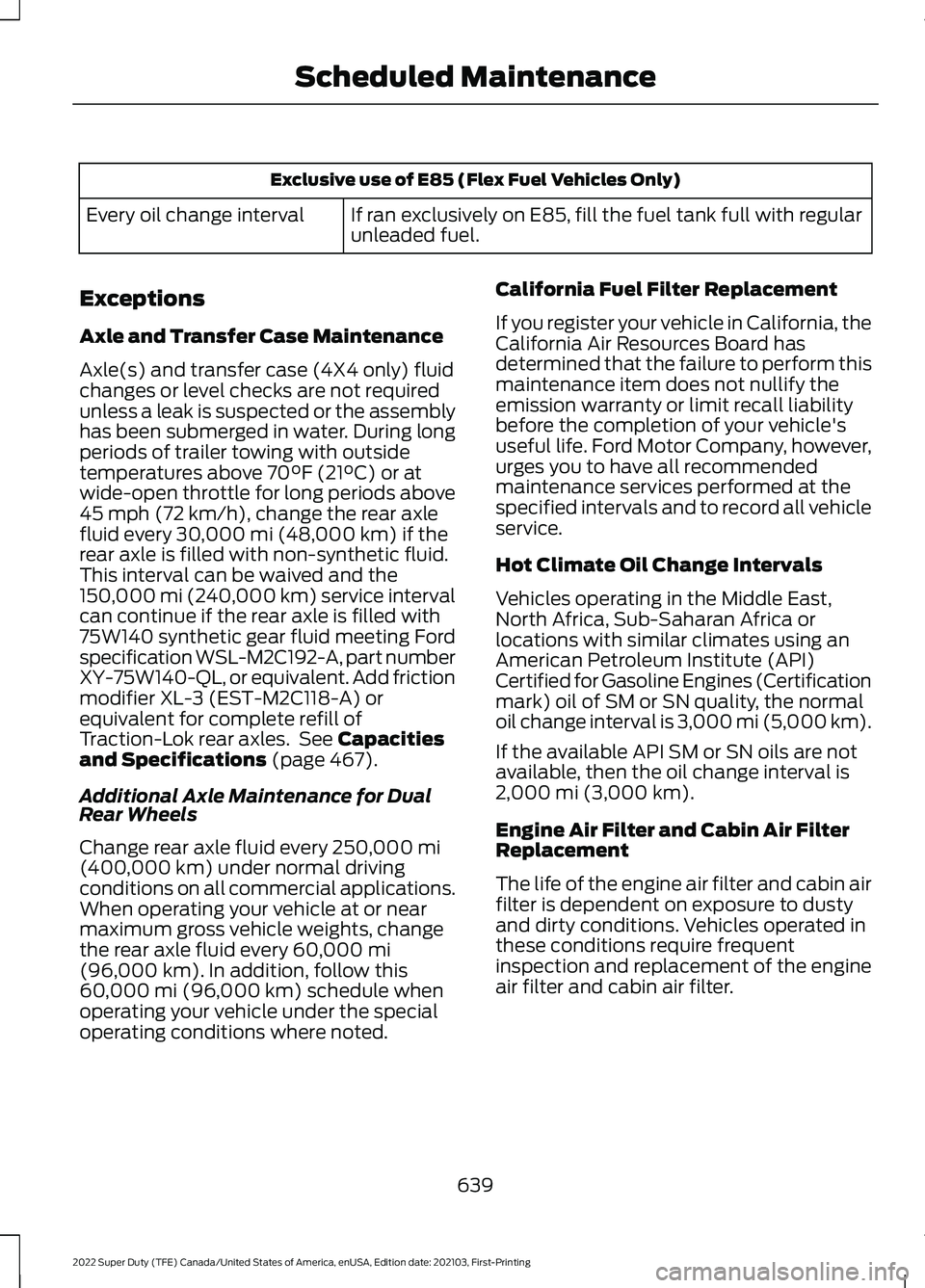2022 FORD F-250 weight
[x] Cancel search: weightPage 500 of 740

VEHICLE IDENTIFICATION
NUMBER
LOCATING THE VEHICLE
IDENTIFICATION NUMBER
The vehicle identification number is on the
left-hand side of the instrument panel.
Note:
In the illustration, XXXX is
representative of your vehicle identification
number.
VEHICLE IDENTIFICATION
NUMBER OVERVIEW
The vehicle identification number contains
the following information: World manufacturer identifier.
A
Brake system, gross vehicle
weight rating, restraint devices
and their locations.
B
Make, vehicle line, series, body
type.
C
Engine or motor type.
D
Check digit.
E
Model year.
F
Assembly plant.
G
Production sequence number.
H
497
2022 Super Duty (TFE) Canada/United States of America, enUSA, Edition date: 202103, First-Printing Vehicle IdentificationE311767 E142477
Page 618 of 740

For a complete listing of the accessories
that are available for your vehicle, please
contact your authorized dealer or visit the
online store web site:
Web Address (United States)
www.Accessories.Ford.com Web Address (Canada)
www.Accessories.Ford.ca
We will repair or replace any properly
authorized dealer-installed Ford Original
Accessory found to be defective in
factory-supplied materials or workmanship
during the warranty period, as well as any
component damaged by the defective
accessories.
We will warrant your Ford Original
Accessory through the warranty that
provides the greatest benefit:
• 24 months, unlimited mileage.
• The remainder of your new vehicle
limited warranty.
Contact an authorized dealer for details
and a copy of the warranty.
Ford Licensed Accessories are the
accessory manufacturer's designs. The
manufacturer develops and therefore
warrants Ford Licensed Accessories, and
does not design or test these accessories
to Ford Motor Company engineering
requirements. Contact an authorized Ford
dealer for the manufacturer ’s limited
warranty details, and request a copy of the
Ford Licensed Accessories product limited
warranty from the accessory manufacturer. For maximum vehicle performance, keep
the following information in mind when
adding accessories or equipment to your
vehicle:
•
When adding accessories, equipment,
passengers and luggage to your
vehicle, do not exceed the total weight
capacity of the vehicle or of the front
or rear axle (GVWR or GAWR as
indicated on the Safety Compliance
Certification label). Ask an authorized
dealer for specific weight information.
• The Federal Communications
Commission (FCC) and Canadian
Radio Telecommunications
Commission (CRTC) regulate the use
of mobile communications systems
that are equipped with radio
transmitters, for example two-way
radios, telephones and theft alarms.
Any such equipment installed in your
vehicle should comply with Federal
Communications Commission (FCC)
and Canadian Radio
Telecommunications Commission
(CRTC) regulations and should be
installed only by an authorized dealer.
• An authorized dealer needs to install
mobile communications systems.
Improper installation may harm the
operation of your vehicle, particularly
if the manufacturer did not design the
mobile communication system
specifically for automotive use.
• If you or an authorized Ford dealer add
any non-Ford electrical or electronic
accessories or components to your
vehicle, you may adversely affect
battery performance and durability. In
addition, you may also adversely affect
the performance of other electrical
systems in the vehicle.
615
2022 Super Duty (TFE) Canada/United States of America, enUSA, Edition date: 202103, First-Printing Accessories
Page 635 of 740

Frequent Low-speed Operation, Consistent Heavy Traffic Under 25 mph (40 km/h) or
Long Rush-hour Traffic
Change the engine oil and filter as indicated by the
information display, and perform the services listed in the
scheduled maintenance chart.
As required
Replace the engine-mounted and frame-mounted fuel
filters.
Every 15,000 mi
(24,000 km), six months or
600 engine hours
Flush and refill the coolant.
Every
60,000 mi
(96,000 km) or 2400
engine hours
Note: After the initial coolant flush and fill at
60,000 mi (96,000 km) or 2400 engine
hours, flush and fill every 45,000 mi (72,000 km) or 1800 engine hours thereafter. Sustained High-speed Driving at Gross Vehicle Weight Rating (Maximum Loaded Weight
for Vehicle Operation)
Change the engine oil and filter as indicated by the
information display, and perform the services listed in the
scheduled maintenance chart.
As required
Replace the engine-mounted and frame-mounted fuel
filters.
Every
15,000 mi
(24,000 km), six months or
600 engine hours
Replace the wheel bearing grease and grease seals if using
non-sealed bearings. (Two-wheel drive vehicles)
Every
30,000 mi
(48,000 km)
Flush and refill the coolant.
Every
60,000 mi
(96,000 km) or 2400
engine hours
Note: After the initial coolant flush and fill at
60,000 mi (96,000 km) or 2400 engine
hours, flush and fill every 45,000 mi (72,000 km) or 1800 engine hours thereafter.
632
2022 Super Duty (TFE) Canada/United States of America, enUSA, Edition date: 202103, First-Printing Scheduled Maintenance
Page 638 of 740

Using Biodiesel, up to and Including 20% Biodiesel (B20)
Change the engine oil and filter as indicated by the
information display, and perform the services listed in the
scheduled maintenance chart.
As required
Replace the engine-mounted and frame-mounted fuel
filters.
Every 15,000 mi
(24,000 km), six months or
300 engine hours Using Fuel Other Than Ultra-low Sulfur Diesel Fuel - Vehicles Operated Where Ultra-low
Sulfur Diesel Fuel is not Required or Available
Change engine oil and filter.
Every
2,500 mi (4,000 km)
or three months (if using
high sulfur fuel with more
than 500 ppm sulfur)
Change engine oil and filter.
Every
5,000 mi (8,000 km)
or six months (if using high
sulfur fuel with fewer than
500 ppm sulfur)
Exceptions
Axle and Transfer Case Maintenance
Axle(s) and transfer case (4X4 only) fluid
changes or level checks are not required
unless a leak is suspected or the assembly
has been submerged in water. During long
periods of trailer towing with outside
temperatures above
70°F (21°C) or at
wide-open throttle for long periods above
45 mph (72 km/h)
, change the rear axle
fluid every 30,000 mi (48,000 km) if the
rear axle is filled with non-synthetic fluid.
This interval can be waived and the
150,000 mi (240,000 km) service interval
can continue if the rear axle is filled with
75W140 synthetic gear fluid meeting Ford specification WSL-M2C192-A, part number
XY-75W140-QL, or equivalent. Add friction
modifier XL-3 (EST-M2C118-A) or
equivalent for complete refill of
Traction-Lok rear axles. See
Capacities
and Specifications (page 467).
Additional Axle Maintenance for Dual
Rear Wheels
Change rear axle fluid every
250,000 mi
(400,000 km) under normal driving
conditions on all commercial applications.
When operating your vehicle at or near
maximum gross vehicle weights, change
the rear axle fluid every
60,000 mi
(96,000 km). In addition, follow this
60,000 mi (96,000 km) schedule when
operating your vehicle under the special
operating conditions where noted.
635
2022 Super Duty (TFE) Canada/United States of America, enUSA, Edition date: 202103, First-Printing Scheduled Maintenance
Page 642 of 740

Exclusive use of E85 (Flex Fuel Vehicles Only)
If ran exclusively on E85, fill the fuel tank full with regular
unleaded fuel.
Every oil change interval
Exceptions
Axle and Transfer Case Maintenance
Axle(s) and transfer case (4X4 only) fluid
changes or level checks are not required
unless a leak is suspected or the assembly
has been submerged in water. During long
periods of trailer towing with outside
temperatures above 70°F (21°C) or at
wide-open throttle for long periods above
45 mph (72 km/h)
, change the rear axle
fluid every 30,000 mi (48,000 km) if the
rear axle is filled with non-synthetic fluid.
This interval can be waived and the
150,000 mi (240,000 km) service interval
can continue if the rear axle is filled with
75W140 synthetic gear fluid meeting Ford
specification WSL-M2C192-A, part number
XY-75W140-QL, or equivalent. Add friction
modifier XL-3 (EST-M2C118-A) or
equivalent for complete refill of
Traction-Lok rear axles. See
Capacities
and Specifications (page 467).
Additional Axle Maintenance for Dual
Rear Wheels
Change rear axle fluid every
250,000 mi
(400,000 km) under normal driving
conditions on all commercial applications.
When operating your vehicle at or near
maximum gross vehicle weights, change
the rear axle fluid every
60,000 mi
(96,000 km). In addition, follow this
60,000 mi (96,000 km) schedule when
operating your vehicle under the special
operating conditions where noted. California Fuel Filter Replacement
If you register your vehicle in California, the
California Air Resources Board has
determined that the failure to perform this
maintenance item does not nullify the
emission warranty or limit recall liability
before the completion of your vehicle's
useful life. Ford Motor Company, however,
urges you to have all recommended
maintenance services performed at the
specified intervals and to record all vehicle
service.
Hot Climate Oil Change Intervals
Vehicles operating in the Middle East,
North Africa, Sub-Saharan Africa or
locations with similar climates using an
American Petroleum Institute (API)
Certified for Gasoline Engines (Certification
mark) oil of SM or SN quality, the normal
oil change interval is 3,000 mi (5,000 km).
If the available API SM or SN oils are not
available, then the oil change interval is
2,000 mi (3,000 km)
.
Engine Air Filter and Cabin Air Filter
Replacement
The life of the engine air filter and cabin air
filter is dependent on exposure to dusty
and dirty conditions. Vehicles operated in
these conditions require frequent
inspection and replacement of the engine
air filter and cabin air filter.
639
2022 Super Duty (TFE) Canada/United States of America, enUSA, Edition date: 202103, First-Printing Scheduled Maintenance
Page 714 of 740

Tampering with emissions
control systems including
related sensors or the Diesel
Exhaust Fluid system can result in reduced
engine power and the illumination of the
service engine soon light.
Tampering With a Noise Control
System
Federal laws prohibit the following acts:
• Removal or rendering inoperative by
any person other than for purposes of
maintenance.
• Repair or replacement of any device or
element of the design incorporated into
a new vehicle for the purpose of noise
control prior to its sale or delivery to
the ultimate purchaser or while it is in
use.
• The use of the vehicle after any person
removes or renders inoperative any
device or element of the design.
The U.S. Environmental Protection Agency
may presume to constitute tampering as
follows:
• Removal of hood blanket, fender apron
absorbers, fender apron barriers,
underbody noise shields or acoustically
absorptive material.
• Tampering or rendering inoperative the
engine speed governor, to allow engine
speed to exceed manufacturer
specifications.
If the engine does not start, runs rough,
experiences a decrease in engine
performance, experiences excess fuel
consumption or produces excessive
exhaust smoke, check for the following:
• A plugged or disconnected air inlet
system hose.
• A plugged engine air filter element.
• Water in the fuel filter and water
separator. •
A clogged fuel filter.
• Contaminated fuel.
• Air in the fuel system, due to loose
connections.
• An open or pinched sensor hose.
• Incorrect engine oil level.
• Incorrect fuel for climatic conditions.
• Incorrect engine oil viscosity for
climactic conditions.
Note: Some vehicles have a lifetime fuel
filter that is integrated with the fuel tank.
Regular maintenance or replacement is not
needed.
Note: If these checks do not help you
correct the concern, have your vehicle
checked as soon as possible.
Noise Emissions Warranty,
Prohibited Tampering Acts and
Maintenance
On January 1, 1978, Federal regulation
became effective governing the noise
emission on trucks over 10,000 lb
(4,536 kg) Gross Vehicle Weight Rating
(GVWR). The preceding statements
concerning prohibited tampering acts and
maintenance, and the noise warranty
found in the Warranty Guide, are
applicable to complete chassis cabs over
10,000 lb (4,536 kg)
GVWR.
EXPORT UNIQUE OPTIONS
For your particular global region, your
vehicle may be equipped with features and
options that are different from the features
and options that are described in this
Owner ’s Manual. A market unique
supplement may be supplied that
complements this book. By referring to the
market unique supplement, if provided,
you can properly identify those features,
recommendations and specifications that
are unique to your vehicle. This Owner ’s
711
2022 Super Duty (TFE) Canada/United States of America, enUSA, Edition date: 202103, First-Printing Customer Information
Page 728 of 740

Garage Door Opener Precautions..........176
Garage Door Opener Radio Frequencies..................................................179
General Maintenance Information
........622
Glasses Holder..............................................190
Locating the Glasses Holder.......................... 190
Glossary of Tire Terminology..................435
Glove Compartment
....................................187
Locking the Glove Compartment.................187
Opening the Glove Compartment................187
H
Headlamp Adjusting See: Adjusting the Headlamps....................... 411
Headlamps
......................................................118
Headlamp Indicators......................................... 118
Using the High Beam Headlamps.................118
Headlamps – Troubleshooting
................118
Headlamps – Frequently Asked
Questions.......................................................... 118
Heated Seats
.................................................165
Heated Seat Precautions................................ 165
Switching the Heated Seats On and Off....................................................................... 165
Heating See: Climate Control - Vehicles With:
Automatic Temperature Control.............149
See: Climate Control - Vehicles With: Manual Temperature Control.................................... 154
Hill Descent Control...................................254 Hill Descent Control –
Troubleshooting............................................ 255
Hill Descent Control Indicator.................254
Hill Descent Control Precautions..........254
Hill Descent Control – Troubleshooting........................................255
Hill Descent Control – Information Messages......................................................... 255
Hill Start Assist
.............................................246
Hill Start Assist – Troubleshooting.............246
Hill Start Assist Precautions...................246
Hill Start Assist – Troubleshooting........................................246
Hill Start Assist – Information Messages......................................................... 246
Hitches.............................................................323 Fifth-Wheel Trailer Hitch................................. 325Hooking Up a Trailer Using a
Weight-Distributing Hitch.......................... 324
Installing a Hitch................................................ 323
Hood Lock See: Opening and Closing the Hood..........396
Horn....................................................................112
How Does 911 Assist Work
..........................67
How Does Adaptive Cruise Control Work...............................................................272
How Does Blind Spot Information System Work
..............................................293
How Does Cross Traffic Alert Work..............................................................298
How Does Drive Mode Control Work...............................................................281
How Does Driver Alert Work...................309
How Does Easy Entry and Exit Work.................................................................93
How Does Four-Wheel Drive Work
.......228
How Does Hill Descent Control Work..............................................................254
How Does Hill Start Assist Work
...........246
How Does Pre-Collision Assist Work...............................................................301
How Does Stability Control Work
.........249
How Does the 360 Degree Camera Work..............................................................266
How Does the Diesel Particulate Filter Work................................................................212
How Does the Electronic Locking Differential Work
.......................................237
How Does the Garage Door Opener Work................................................................176
How Does the Lane Keeping System Work..............................................................286
How Does the Rear Occupant Alert System Work.................................................171
How Does the Safety Canopy ™
Work.................................................................58
How Does the Selective Catalytic Reduction System Work
..........................217
How Does Traction Control Work..........247
How Does Trailer Backup Assistance Work..............................................................339
How Does Trailer Reverse Guidance Work...............................................................357
How Does Trailer Sway Control Work..............................................................338
725
2022 Super Duty (TFE) Canada/United States of America, enUSA, Edition date: 202103, First-Printing Index
Page 738 of 740

Tire Pressure Monitoring System
Limitations..................................................449
Tire Pressure Monitoring System Overview......................................................448
Tire Pressure Monitoring System Precautions................................................449
Tire Pressure Monitoring System..........448 Tire Pressure Monitoring System –
Troubleshooting............................................ 453
Tire Pressure Monitoring System – Troubleshooting........................................453
Tire Pressure Monitoring System – Information Messages................................ 454
Tire Pressure Monitoring System – Warning Lamps............................................................... 453
Tire Replacement Requirements..........436
Tire Rotation.................................................446
Towing a Trailer Limitations....................329
Towing a Trailer Precautions
...................328
Towing a Trailer............................................328 Towing a Trailer – Troubleshooting.............333
Towing Weights and Dimensions.................331
Towing a Trailer – Troubleshooting
........................................333
Towing a Trailer – Information
Messages......................................................... 333
Towing Weights and Dimensions...........331 Calculating the Maximum Loaded Trailer
Weight for Your Vehicle.............................. 332
Recommended Towing Weights................... 331
What Is the Maximum Loaded Trailer Weight............................................................... 332
Towing Your Vehicle Precautions
..........384
Towing Your Vehicle...................................384 Towing Your Vehicle –
Troubleshooting............................................ 386
Towing Your Vehicle – Troubleshooting.......................................386
Towing Your Vehicle – Information Messages......................................................... 386
Traction Control Indicator
.........................247
Traction Control............................................247
Traction Control – Troubleshooting...........248
Traction Control – Troubleshooting........................................248
Traction Control – Information Messages......................................................... 248
Trail Control Indicators...............................252 Trail Control
....................................................252
Trail Control – Troubleshooting................... 253
Trail Control – Troubleshooting
.............253
Trail Control – Information
Messages......................................................... 253
Trailer Backup Assistance Precautions.................................................339
Trailer Backup Assistance
........................339
Setting Up the Trailer Backup Assistance
for a Conventional Trailer.......................... 339
Setting Up the Trailer Backup Assistance for a Fifth-Wheel or Gooseneck
Trailer................................................................. 343
Trailer Backup Assistance – Troubleshooting............................................ 349
Trailer Backup Assistance – Troubleshooting........................................349
Trailer Backup Assistance – Frequently Asked Questions........................................... 352
Trailer Backup Assistance – Information Messages......................................................... 349
Trailer Brake Precautions..........................328
Trailer Reverse Guidance Precautions.................................................357
Trailer Reverse Guidance
...........................357
Setting Up Trailer Reverse Guidance for a
Conventional Trailer..................................... 357
Setting Up Trailer Reverse Guidance for a Fifth-Wheel or Gooseneck Trailer..........360
Trailer Reverse Guidance – Troubleshooting............................................ 364
Trailer Reverse Guidance – Troubleshooting........................................364
Trailer Reverse Guidance – Frequently Asked Questions........................................... 366
Trailer Reverse Guidance – Information Messages......................................................... 364
Trailer Sway Control Precautions..........338
Trailer Sway Control
...................................338
Trailer Towing Hints....................................329
Trailer Towing Navigation..........................612
Transfer Case Fluid Capacity and Specification..............................................490
Transporting the Vehicle...........................383
Trip Computer................................................145
Trip Data...........................................................145
735
2022 Super Duty (TFE) Canada/United States of America, enUSA, Edition date: 202103, First-Printing Index